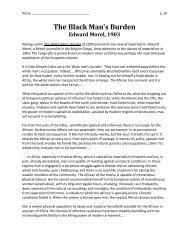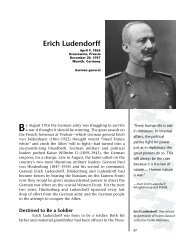Edith Cavell
Edith Cavell
Edith Cavell
You also want an ePaper? Increase the reach of your titles
YUMPU automatically turns print PDFs into web optimized ePapers that Google loves.
ecame a safe house where many of these men stayed while trying<br />
to get out of Belgium. Ryder quotes one of the soldiers<br />
<strong>Cavell</strong> rescued, who wrote the following words to <strong>Cavell</strong>’s<br />
mother after <strong>Cavell</strong> was executed: “You will be surprised to<br />
receive this letter from me, a stranger, but had it not been for<br />
your daughter, I should undoubtedly have suffered the same<br />
fate. . . . I can only say, she has done a great deal more for her<br />
country than most of the men who are in England at present,<br />
and although I feel the deepest sympathy for you I am sure you<br />
will be proud to have such an heroic daughter.”<br />
In the summer of 1915, the Germans began threatening<br />
some members of the resistance network, but <strong>Cavell</strong><br />
refused to leave her post at the clinic. She was taken prisoner<br />
on August 5 and locked in a cell at St. Gilles Prison. During the<br />
next few days, she signed several statements written in German<br />
admitting that she had participated in resistance activities;<br />
it is believed that the statements were not accurately<br />
translated into French for her. While awaiting trial, she drew<br />
strength from reading the Imitation of Christ, Thomas á Kempis’s<br />
fifteenth century devotional book, and continued to write<br />
encouraging letters to the nurses at her clinic. In October,<br />
<strong>Cavell</strong> and thirty-four other prisoners, including Princess<br />
Marie de Croÿ, were put on trial. The unfair proceedings—<br />
which were conducted in German by judges who were already<br />
biased against the defendants—sent <strong>Cavell</strong> and four others to<br />
their deaths, while the other prisoners were sentenced to terms<br />
of hard labor varying from two to fifteen years; Marie de Croÿ<br />
was sentenced to ten. After writing a last, loving letter to her<br />
staff, in which she urged them to maintain their devotion to<br />
their patients and asked their forgiveness for any wrongs,<br />
<strong>Cavell</strong> was executed by an eight-man firing squad early on the<br />
morning of October 12, 1915. It was not until 1919, however,<br />
that <strong>Edith</strong> <strong>Cavell</strong>’s body was disinterred (dug up) and returned<br />
to England, amidst a huge outpouring of public grief.<br />
<strong>Edith</strong> <strong>Cavell</strong>’s execution helped fuel the wartime belief<br />
that the Germans were brutal. British propagandists portrayed<br />
<strong>Cavell</strong> as the epitome (personification) of innocence and<br />
humanitarianism. Playwright George Bernard Shaw referred to<br />
<strong>Cavell</strong> in the introduction to Saint Joan, his play about Joan of<br />
Arc, the brave young woman who led French troops to victory<br />
over the English in the fifteenth century. Several decades after<br />
<strong>Edith</strong> <strong>Cavell</strong> 25

















